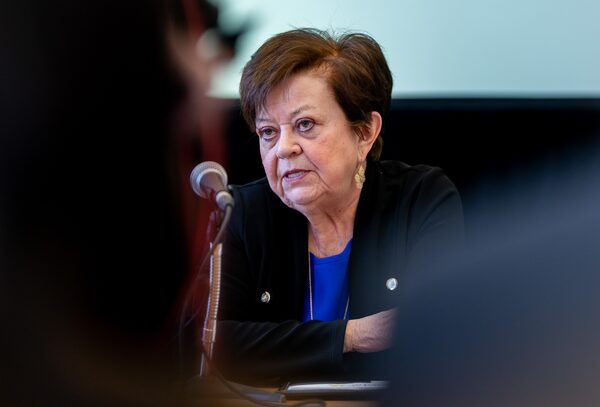
Saskatchewan Finance Minister Donna Harpauer speaks in Regina, on March 22.Heywood Yu/The Canadian Press
The Saskatchewan government is forecasting a $250-million deficit this fiscal year due to higher expenses related to the summer drought and lower projected resource revenues.
The mid-year financial report outlined Monday forecasts Saskatchewan is to spend about $1.3 billion more than it had budgeted.
The province initially forecast a surplus of more than $1 billion.
Finance Minister Donna Harpauer told reporters the deficit is a result of unforeseen drought that reduced production by 20 per cent, resulting in more crop insurance payouts.
The report says the province expects to spend $853 million more on agriculture.
“I want to be clear that we’re not attributing this deficit to producers,” Harpauer said.
The mid-year report says the deficit is also due to a decrease in forecast potash revenues, as prices and production have declined.
The report forecasts the province won’t see $717.8 million in resource revenues it had expected to get.
Harpauer said no one was able to accurately predict how Russia’s invasion of Ukraine would affect commodity prices and production levels.
She said despite the sanctions western countries imposed on Russia, potash from Russia and Belarus have continued to flow into China and India.
“We rely totally on the forecasts of the industry themselves,” Harpauer said. “So, I don’t think they were certain of when the market would go back to Russia and Belarus.”
Harpauer said the province will continue to rely on industry forecasts, adding she believes predictions for potash have normalized.
“The huge spikes that we’ve seen a year and two years ago are probably not going to happen again in the near future,” she said.
Harpauer said there are no plans to increase the agriculture budget to soften potential financial blows, even though climate scientists have predicted drier years in the future.
In addition to higher agriculture expenses, the province expects to spend $111 million more this year on efforts to fight wildfires.
It also forecasts it will spend an additional $270.7 million on education and an extra $45.3 million for pension inflation adjustments.
Despite resource revenue losses, the province forecasts a $414.7-million increase in taxation revenue.
It’s also forecasting an increase of $204.4 million from government business enterprises. Federal transfers are also predicted to increase by $10.9 million.
Debt is now estimated to be $31.6 billion, up $709 million from what was budgeted.
Harpauer said she believes there are no structural issues in the budget, adding resource revenues can be volatile.
She said the province decided not to reduce capital spending, as many projects are already under construction.
“There may be some projects that will be slow-walked a little bit, but it’s a rolling a plan,” she said.
Harpauer added it’s likely there won’t be tax cuts in next spring’s budget.
“But we’re very early in our budget operations, and we’ll see how the economy goes,” she said.
The finance minister said she’s still optimistic about the future, pointing to Saskatchewan’s economic indicators.
The province’s unemployment rate is relatively low at 4.4 per cent. The national average is 5.7 per cent. Saskatchewan’s GDP also grew this year.
“People are looking for jobs and opportunity,” she said. “Even though there is inflationary pressures, when you look at taxes, utility and housing costs, we’re the most affordable in the country.”
The Opposition NDP said Monday that the deficit shows the Saskatchewan Party government has failed to manage taxpayer dollars.
“Instead of growing the economy, they’ve become more and more dependent on hiking taxes and costs on the people of Saskatchewan during an affordability crisis,” NDP Leader Carla Beck said in a statement.
“We’re all paying more to cover the cost of their mismanagement.”